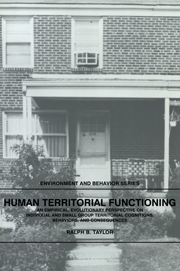 Human Territorial Functioning
Human Territorial Functioning Book contents
- Frontmatter
- Contents
- List of figures, tables, and boxes
- Series foreword
- Preface
- Acknowledgments
- 1 Introduction
- PART I ORIGINS OF HUMAN TERRITORIAL FUNCTIONING
- PART II A CONCEPTUAL MODEL OF HUMAN TERRITORIAL FUNCTIONING
- PART III TERRITORIAL FUNCTIONING IN SETTINGS OF VARYING CENTRALITY
- 7 Interior residential settings
- 8 Territorial functioning in outdoor residential spaces close to the home
- 9 Regular use settings
- 10 Minimal territorial functioning
- PART IV APPLICATIONS TO SOCIAL PROBLEMS
- PART V REVIEW AND PROSPECTS
- Index
7 - Interior residential settings
Published online by Cambridge University Press: 05 February 2010
- Frontmatter
- Contents
- List of figures, tables, and boxes
- Series foreword
- Preface
- Acknowledgments
- 1 Introduction
- PART I ORIGINS OF HUMAN TERRITORIAL FUNCTIONING
- PART II A CONCEPTUAL MODEL OF HUMAN TERRITORIAL FUNCTIONING
- PART III TERRITORIAL FUNCTIONING IN SETTINGS OF VARYING CENTRALITY
- 7 Interior residential settings
- 8 Territorial functioning in outdoor residential spaces close to the home
- 9 Regular use settings
- 10 Minimal territorial functioning
- PART IV APPLICATIONS TO SOCIAL PROBLEMS
- PART V REVIEW AND PROSPECTS
- Index
Summary
But, you may say, we asked you to speak about women and fiction. … All I could do was to offer you an opinion upon one minor point – a woman must have money and a room of her own if she is to write fiction
– Virginia Woolf, A Room of One's Own (1929)How does territorial functioning operate in settings where people live? This is the main question addressed in this chapter. A range of interior residential settings will be examined, spanning intact households, dorm settings, institutional residential settings, and experimental groups in isolation.
These various sites share three characteristics. (1) For a period of time, small groups, ranging in size from two to more than a dozen, live in these settings; they take up residence there and share space. It is there that the “strongest” territories exist. These spaces represent the core of the group's spatial activity system. (2) Interior residential settings are strongly multifunctional. (3) And, in these settings, co-occupants have frequent contact over a period of time. The objective diversities of the settings examined here are outweighed by the similarities in subjective significance and individual and group functioning.
Investigating territorial functioning in interior residential settings is frustrating for two reasons. First, the settings in question are highly private, causing operational as well as ethical problems for researchers (see the following box). Consequently, there is a paucity of solid data for some of the settings considered. Second, territorial functioning is often latent one is not aware of it unless changes impinge (see Figure 7.1). This submerged nature of territorial functioning makes its examination all the more difficult.
- Type
- Chapter
- Information
- Human Territorial FunctioningAn Empirical, Evolutionary Perspective on Individual and Small Group Territorial Cognitions, Behaviors, and Consequences, pp. 136 - 165Publisher: Cambridge University PressPrint publication year: 1988
- 1
- Cited by


